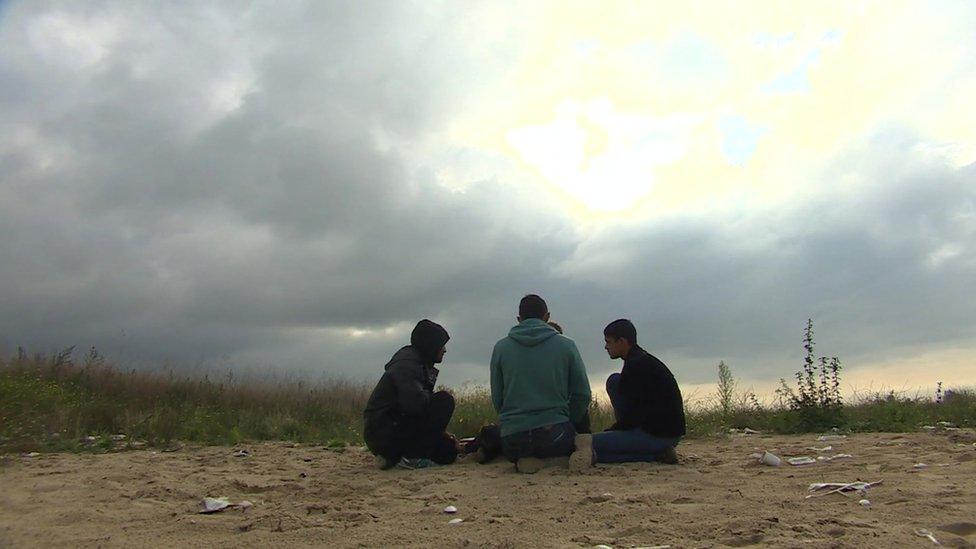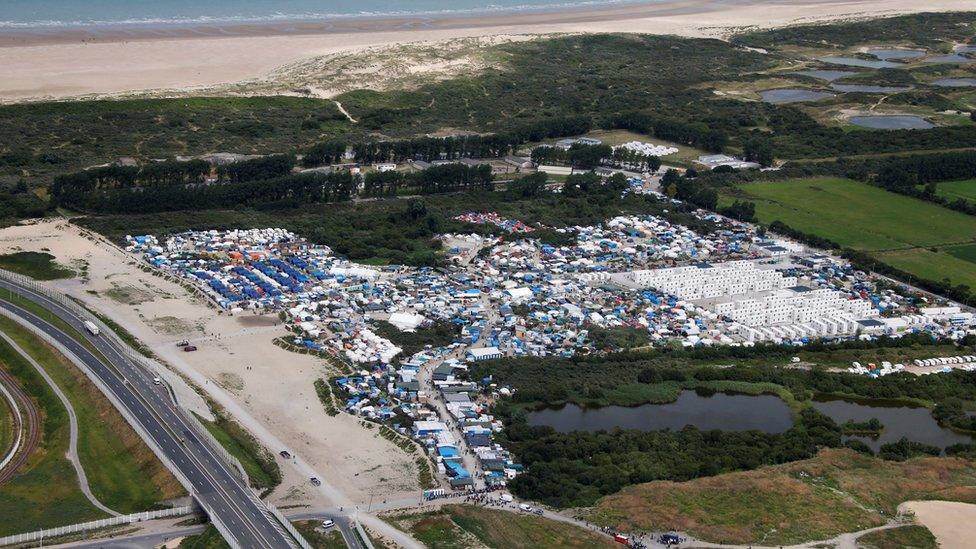The desperate children of the Calais Jungle
- Published
Mohammed, an unaccompanied 16-year-old from Eritrea, in a cloud of tear gas at the "Jungle" camp in Calais
Another day in the "Jungle", another tear-gassing for the children of Calais.
As a convoy is diverted too close to the migrant camp, shouts go up, gangs of young men and boys charge through the underpass which forms the entrance to the camp, desperate to board the trucks.
French police are quick to respond, and soon CS canisters are exploding among the migrants, forcing them back into the camp.
Among them is Mohammed, 16. His lungs and eyes are full of the choking gas.
He has no-one here to look after him, and he desperately wants to get to Britain.
The Calais conversation that left Lily Allen in tears
'Robust plans' called for to resettle Calais migrant children
He's far from the only child - or "unaccompanied minor" as the jargon has it - in the camp.
Brothers Jamshed and Ahjamal, aged 14 and 16, are from Afghanistan. They left their home country six months ago, and are trying to join family in London.
"This is obviously not a place where you can feel happy," they tell me. "We are sad and want to be with our brother, father and cousin and want help with the transfer because we are young and don't know how to go about it.
"Tell them to move us from here!"
Estimates vary, but charities put the numbers of unaccompanied minors in the camp at about 1,000. The British government wants to move those who have families in the UK to Britain before the camp is demolished in the next few weeks.
Other children who are on their own and who arrived before 20 March may qualify to move to Britain as well, although some will be resettled in France.

Those youngsters who have family in the UK hope they will be united with them in coming weeks - before the camp is demolished
Hasan is 13, also from Afghanistan. He wants to be an engineer, but it is a year since he last attended school. He talks nervously, afraid of who might be listening as he tells us.
"I don't have family here - just me," he tells me.
"I have family in the UK. Just help me to go to England."
Cricket in the filth
Hasan is young for the Jungle - most children here are older teenagers - but some are younger still.
Bilal is just 11 and comes from Afghanistan. His skill with bat and ball makes him a prized player in the informal cricket matches which take place just outside the main camp once the clouds of tear gas have cleared.
The scene could be a village cricket match anywhere in South Asia, but look around and the razorwire fences; the filthy, leaking shacks; and the piles of human waste tell a different story. This is no place for anyone to live, let alone a child.
There is no doubt the Jungle is an unsafe place for anybody, especially children. Because it is an unofficial camp, there is no central organising authority and, aside from the odd raid, no police presence to keep order or report crime to.
A recent Red Cross report highlighted dangers to children in the camp, external including sexual exploitation, forced labour, trafficking gangs and smugglers. The roads where children try to get on trucks present a constant danger of being killed or injured, and the camp has unsafe food, poor sanitation and inadequate healthcare - perfect conditions for spreading disease.
Soon the camp itself will be erased as French police and bulldozers move in.
That impending destruction has at last concentrated minds on the children of Calais.

What is the Jungle?

The Jungle camp is close to the main road to Calais port
The "Jungle" camp is near the port of Calais, and close to the 31-mile Channel Tunnel
Officially, about 7,000 migrants live in the camp - humanitarian groups say the number is closer to 10,000
Despite an increasing population, the camp's size was halved earlier this year
But the camp's population has continued to rise, and reports of violence have increased
Many migrants attempt to hide themselves in cargo vehicles entering the Channel Tunnel
The area has been hit by protests and the government has vowed to shut the camp by the end of 2016